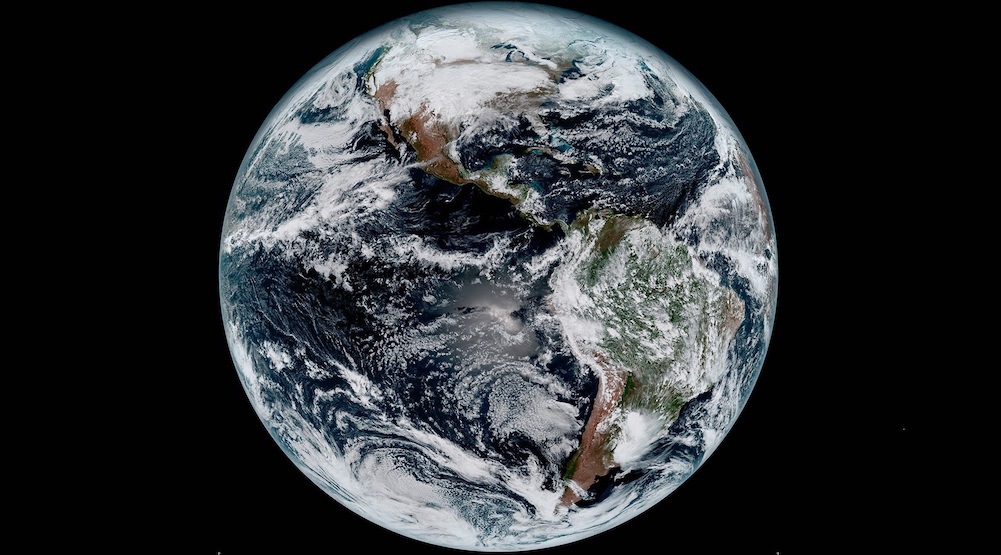To better understand the basics of how the planet works we will use the analogy of a chicken egg. The yolk would represent the core – solid and in the middle of the planet. The mantle would be like the egg white that surrounds the yolk. It takes up most of the space, is fluid, and slowly rises and falls as it is heated by the core. The eggshell would represent the crust of the earth. Solid, and very thin. However, the crust of our planet is not smooth. It is covered with mountains and valleys, some of it above sea level but most (70%) would be below the oceans. And above the eggshell would be a thin layer of gas we call the atmosphere.
What we know of the core of the planet has come from seismic waves we have generated. As sound waves pass through different materials, the waves bend and reflect differently. The patterns of the refraction and reflection suggest that the core is made of iron and nickel. The temperatures here are extreme – up to 9000°F – but the intense pressure generated by gravity keeps the inner core a solid – like our egg yolk.
The mantle is actually solid rock but moves VERY slowly like a thick liquid – similar to glaciers. Like the core – the mantle is very hot but the pressure there keeps in a more solid fluid state. However, as this rock layer comes closer to the crust, the temperature is high enough, and the pressure low enough, that it becomes more fluid like – and we call it magma. This upper portion of the mantle is known by geologists as the asthenosphere.
The crust is made of solid igneous rock that is basically cooled magma. Granite is the rock that makes up the continental land masses and the denser basalt is found on the ocean floors – basalt “sinks” deeper into the more fluid mantle. Geologists call the crust the lithosphere.
The ocean is made of 97% water and 3% salt. This saltwater makes up 90% of the water on the planet. Freshwater can be found on land and in the ice of the polar regions. They refer to all of the water on the planet as the hydrosphere.
The air above the planet is a thin layer of gases made primarily of nitrogen, but also includes oxygen, carbon dioxide and other trace gases. It is called the atmosphere.
If you were to look down on the planet from the north pole it would rotate counterclockwise – from the south pole it would be clockwise. This rotation causes the hydrosphere and atmosphere to “slush around”. Add temperature and pressure change as a cause for this rotation we generate the winds and currents of our planet.
Over the last century scientists have discovered that the crust is cracked, and each section of eggshell is called a plate. These cracks provide places where molten magma can exit into the environment in the form of volcanos. These can be found on both land and at the bottom of the sea. The molten rock cools when it meets the hydrosphere and atmosphere and a cocktail of gases, liquids, and solids are produced. These gases contributed to the formation of the atmosphere that was held close to the planet by gravity.
About one billion years ago some of these molecules formed cell like structures that could take in gases, liquids, and solids and release waste products. This taking in/converting/releasing out of new materials changed the chemistry of the land, sea, and air. Oxygen increased in the atmosphere and the planet cooled to a point where these cell-like structures could live, grow, and reproduce. They produced their own energy to maintain their own metabolism and eventually some cells developed that could not make their own energy and needed to consume the cells that did – predator/prey relationships were developed.
As the planet aged and changed, the living creatures aged and changed. Many creatures could not survive the new changes and went extinct. With the new changes, new creatures would appear. Those had to deal with the conditions of either land, sea, or air and with the other creatures that lived nearby. Interactions between these creatures would change the environment and the process of change in life followed suit.
This is how our planet has functioned since its beginning. The planet changes, the living organisms change, these changes cause more changes, and the planet evolves over time. Today, there are millions of species on the planet and millions more have gone extinct. In the next article we will look at how these systems function in the hydrosphere.
- Our Environment: Part 23 – Hydrogen as an Energy Source - October 29, 2025
- Nurse Shark Spotted in Big Lagoon - October 21, 2025
- Our Environment: Part 22 – Geothermal Energy - October 21, 2025

